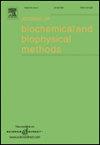Development of potentiometric urea biosensor based on urease immobilized in PVA–PAA composite matrix for estimation of blood urea nitrogen (BUN)
Abstract
A urea biosensor was developed using the urease entrapped in polyvinyl alcohol (PVA) and polyacrylamide (PAA) composite polymer membrane. The membrane was prepared on the cheesecloth support by gamma-irradiation induced free radical polymerization. The performance of the biosensor was monitored using a flow-through cell, where the membrane was kept in conjugation with the ammonia selective electrode and urea was added as substrate in phosphate buffer medium. The ammonia produced as a result of enzymatic reaction was monitored potentiometrically. The potential of the system was amplified using an electronic circuit incorporating operational amplifiers. Automated data acquisition was carried by connecting the output to a 12-bit analog to digital converter card. The sensor working range was 1–1000 mM urea with a response time of 120 s. The enzyme membranes could be reused 8 times with more than 90% accuracy. The biosensor was tested for blood urea nitrogen (BUN) estimation in clinical serum samples. The biosensor showed good correlation with commercial Infinity™ BUN reagent method using a clinical chemistry autoanalyzer. The membranes could be preserved in phosphate buffer containing dithiothreitol, β-mercaptoethanol and glycerol for a period of two months without significant loss of enzyme activity.

 求助内容:
求助内容: 应助结果提醒方式:
应助结果提醒方式:


